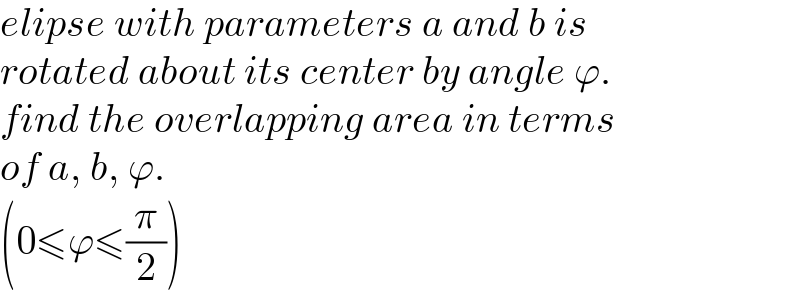
Question and Answers Forum
Question Number 177787 by mr W last updated on 09/Oct/22

Commented by mr W last updated on 09/Oct/22

Answered by mr W last updated on 09/Oct/22

Commented by mr W last updated on 09/Oct/22
![red elipse: (x^2 /a^2 )+(y^2 /b^2 )=1 ((r^2 cos^2 θ)/a^2 )+((y^2 sin^2 θ)/b^2 )=1 ⇒r^2 =((a^2 b^2 )/( b^2 cos^2 θ+a^2 sin^2 θ)) θ_P =(ϕ/2) θ_Q =((π+ϕ)/2)=π−((π/2)−(ϕ/2)) area of sector OPQ of red elipse: A_(sector) =(1/2)∫_θ_P ^θ_Q r^2 dθ overlapping area = 4×sector A_(overlapping) =2∫_θ_P ^θ_Q r^2 dθ =2∫_θ_P ^θ_Q ((a^2 b^2 )/( b^2 cos^2 θ+a^2 sin^2 θ)) dθ =2ab[tan^(−1) ((a/b)×tan θ)]_θ_P ^θ_Q =2ab{π−tan^(−1) [(a/b)×tan ((π/2)−(ϕ/2))]−tan^(−1) ((a/b)×tan (ϕ/2))} =2ab[π−tan^(−1) ((a/b) cot (ϕ/2))−tan^(−1) ((a/b) tan (ϕ/2))]](Q177809.png)
Commented by Tawa11 last updated on 09/Oct/22

